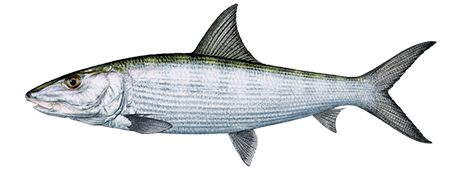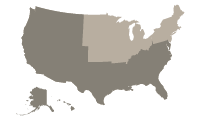
Bonefish
As one might expect from the name, the bonefish has an abundance of bones (some of which are quite tiny), for which reason this fish is less popular as table fare.

Region
South, West
Catch ease
Hard
Habitat
Ocean
How to identify a Bonefish
The dorsal fin consists of 17-19 soft rays. The anal fin has 8-9 soft rays, the ventral fins have 9, and the pectoral fins have 15-17. There are 65-73 scales along the lateral line-none on the head. The sides and belly of the fish are bright silver. Parts of the fins and the snout may show a yellowish or dusky color. Their body is long, thin, and fusiform, with a bluntly conical snout. Bonefish are basically schooling fish. The smaller ones can be seen in large schools on the flats. The larger ones tend to form smaller schools or groups. They feed on crabs, shrimps, clams, sea worms, sea urchins, and small fish that inhabit the sandy flats and intertidal areas. They are often seen rooting in the sand, their tails breaking the surface of the shallow water; an action commonly known as trailing. At other times they will plough the bottom stirring up silt and mud, known as mudding. They are powerful and run very fast and hard when hooked. Fishing methods include plug, fly or spin casting from a skiff or while wading on tidal flats, using shrimp, crabs or similar baits. Most bonefish are caught in depths from 6 inches to 10 ft. (15 cm to 3 m).The species begins life looking more like an eel than a fish and undergoes a leptocephalus larval stage during which it grows to a length of about 2 1/2 in. (6.3 cm); then during a period of metamorphosis the eel-like larva shrinks to half its former size. As it shrinks, fins begin to appear, and after 10-12 days the eel has become a 1.5 in. (3.81 cm) miniature bonefish, and begins to grow again. Tarpon and ladyfish undergo similar stages of development.
Where to catch Bonefish
Occurs worldwide in shallow tropical and subtropical waters around flats and intertidal areas. The following list includes additional details on where to catch this fish:
| Baitfish Patches |
| Cliffs |
| Deep Shore Water |
| Jetties and Breakwaters |
| Night Fishing |
| Saltwater and Tides |
| Surf and Shore |
| Saltwater Weed Beds |
| Breakers |
| Colliding Waves |
| Floating Foam and Debris |
| Merging Water |
| Roily Water |
| Shore Points |
| Tidal Flats |
How to catch Bonefish
The following are fishing methods used to catch this fish:
Bonefish lures, tackle & bait
The following are lures, tackle or bait that can be used to catch this fish:
